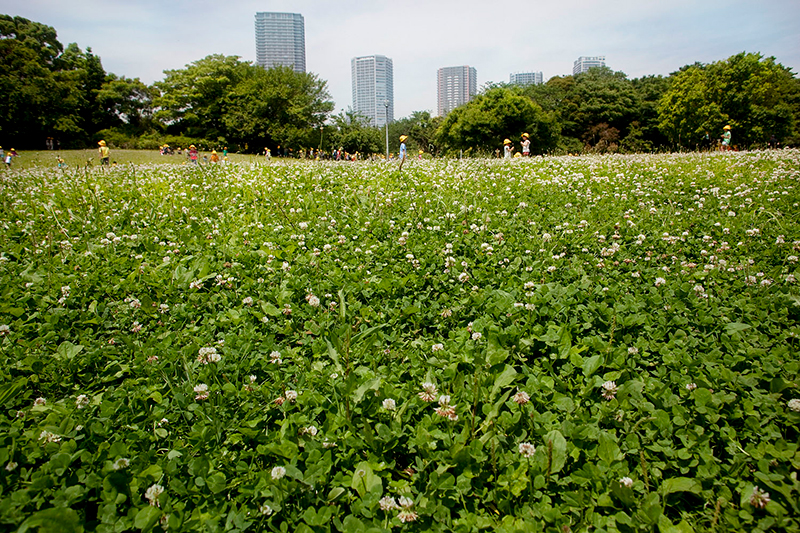The common white clover is both everywhere and nowhere: it grows widely in the grassy areas of cities worldwide but barely takes root in our imagination. Yet this inconspicuous little plant holds a giant clue about how species adapt to urbanization.
Like many organisms, the white clover defends itself against potential predators. Snails, slugs and voles that graze on this herbaceous perennial encounter an unpleasant bitter taste caused by hydrogen cyanide, which can kill them. But new U of T–led research shows that in the world’s concrete jungles, which host fewer foraging herbivores, white clovers have naturally evolved to be less guarded: they are 44 per cent less likely to emit this toxic chemical than their siblings in rural areas.
“This is the first time we’ve documented this kind of pattern happening across the whole world. I think it’s pretty strong evidence that humans are influencing the evolution of the life that surrounds us,” says James Santangelo, who recently earned a PhD in biology at U of T Mississauga. Santangelo helped unearth this new phenomenon in natural selection as a researcher on the Global Urban Evolution Project.
In this first-of-its-kind study, Santangelo and two UTM professors were able to enlist 287 scientists in 26 countries on every continent except Antarctica to study the urban adaptation of white clovers. Fanning out across lawns and parks in Tampa, Helsinki, Cape Town, Tehran and dozens of other cities, they collected some 110,000 samples and sequenced the genomes of more than 2,000 individual plants. Their findings, which were published in Science, clearly show how the plant is undergoing “parallel evolution” – meaning it is biologically changing to adapt to the circumstances of urban life.
“Humans have become the major driver of evolutionary change on Earth,” says Marc Johnson, one of the study’s principal investigators and a U of T Mississauga biology professor. “If we want to keep living here in a sustainable way, we need to better understand this trend.”
Johnson, who leads the EvoEco Lab at UTM and is the Canada Research Chair in Urban Environmental Science, first explored this trend in white clover populations in Toronto. In an earlier study, he found that the frequency of plants producing hydrogen cyanide (a process known as cyanogenesis) increased with greater distance from downtown. A new idea germinated one day while he was in the shower. As he wrote in a project blog post: “Holy cow, we could use white clover to understand whether organisms are adapting to cities in similar ways throughout the entire world.”
The seed was planted, and Johnson attracted interest from Rob Ness, an assistant biology professor at U of T Mississauga, and Santangelo, who was already doing similar research. They initially aimed to include scientists from 50 cities, but after Johnson posted an open invitation on Twitter and circulated the proposal among colleagues, more than triple that number signed up.
The project’s goal was to document the genetic diversity of white clover over a wide geographic range. So, starting on foot at their city’s centre, the participating scientists travelled outwards on linear paths like bicycle spokes, stopping at least every 200 metres to collect 20 plants at up to 50 sites.
The sampling effort turned into a family affair during Johnson’s sabbatical as his two children, then ages 12 and 9, helped pick clovers during travels to Argentina, Chile and Japan. Santangelo himself collected 12,000 clovers on a 16-city road trip in eastern North America, where a stop in some neighbourhoods attracted the wrong kind of attention from residents: “People assume you’re up to no good and want you out of there,” he says.
The global scientists were supported in their work by an equipment kit assembled and delivered to them by the project team – and an emailed link to videos outlining detailed protocols for testing samples and recording results.
Johnson co-ordinated the researchers, and says engaging so many far-flung participants posed some unique challenges. For example, while most collaboration took place via Google Docs and Sheets, a different approach was needed for participants in China, where the government mostly denies access to Google products. He also spent ample time clarifying how to record data. “With so many different people, regions and cultures involved, there were tons of these hiccups,” says Johnson.
Our best shot at conserving most biodiversity is to build more connected green spaces that are uniformly distributed across the city.”
Rob Ness, another of the study’s principal investigators, conducted genomic analysis of the plants, which required some creative problem-solving. “The plants without hydrogen cyanide are missing one or two genes, and detecting the absence of something is tricky,” says Ness. So, he helped design a new analysis to detect missing sections in the clover genomes.
The findings that emerged from the project are still being parsed. Some urban clovers actually showed a higher presence of hydrogen cyanide than their rural counterparts, which the researchers speculate is caused by dryer city conditions. They believe this triggers cyanogenesis as a way for the plant to store nitrogen, which has drought-protective functions. Multiple spinoff projects with project partners are now focusing on further understanding the clover’s genetics and adaptations.
In the meantime, Santangelo says, this study provides fertile soil for reimagining how we approach city building and conservation in the future. “I think clover is going to be just fine, but we may need to be concerned about other species, such as birds that rely on song for mating and whose songs are now disrupted by noise pollution,” he says. “Our best shot at conserving most biodiversity is to build more connected green spaces that are uniformly distributed across the city. That’s how we maintain large populations that are at less risk of going extinct.”



